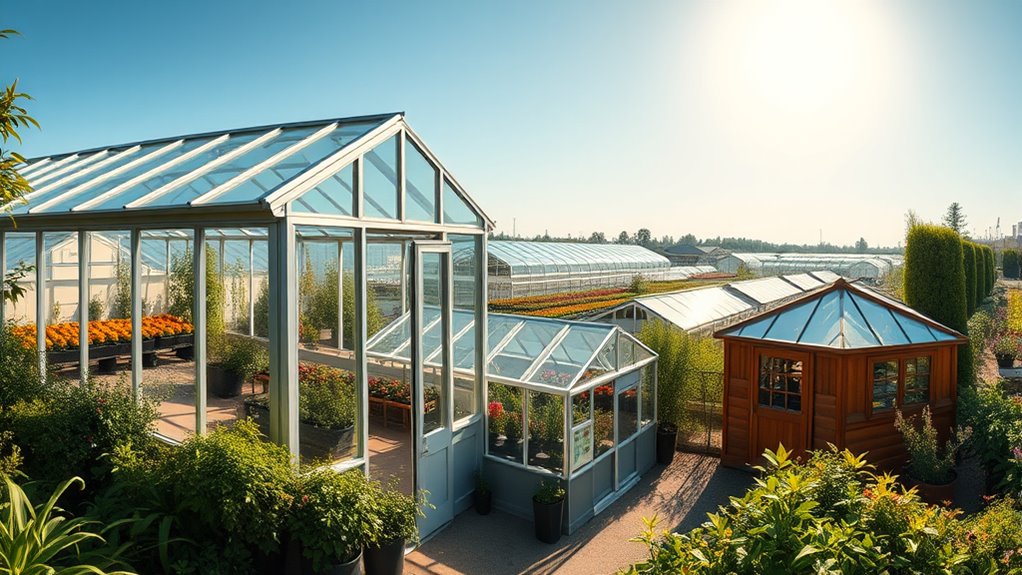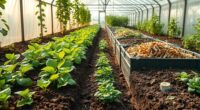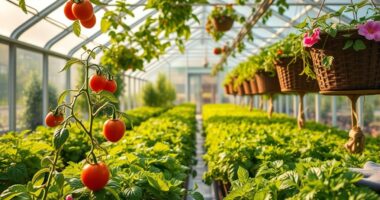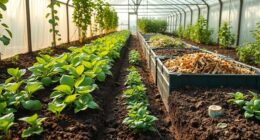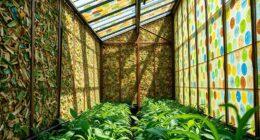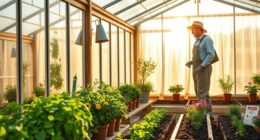Choosing the right greenhouse involves considering your climate, budget, and gardening goals. Decide on the type—like glass for durability or polycarbonate for lightweight insulation—that best suits your environment. Select a size that fits your plant needs without overspending or limiting expansion. Materials influence light, heat retention, and durability, so pick those that align with your conditions. Balancing these factors guarantees ideal plant growth and long-term success; exploring further will help you make the best choice.
Key Takeaways
- Identify your plant types and growing needs to determine the appropriate greenhouse type and features.
- Choose a size that balances your current space, future expansion plans, and budget constraints.
- Select materials like glass, polycarbonate, or polyethylene based on light transmission, insulation, and durability.
- Consider eco-friendly features such as solar heating and passive solar design to enhance sustainability.
- Evaluate ventilation, pest control options, and structural strength to ensure a healthy environment for plants.
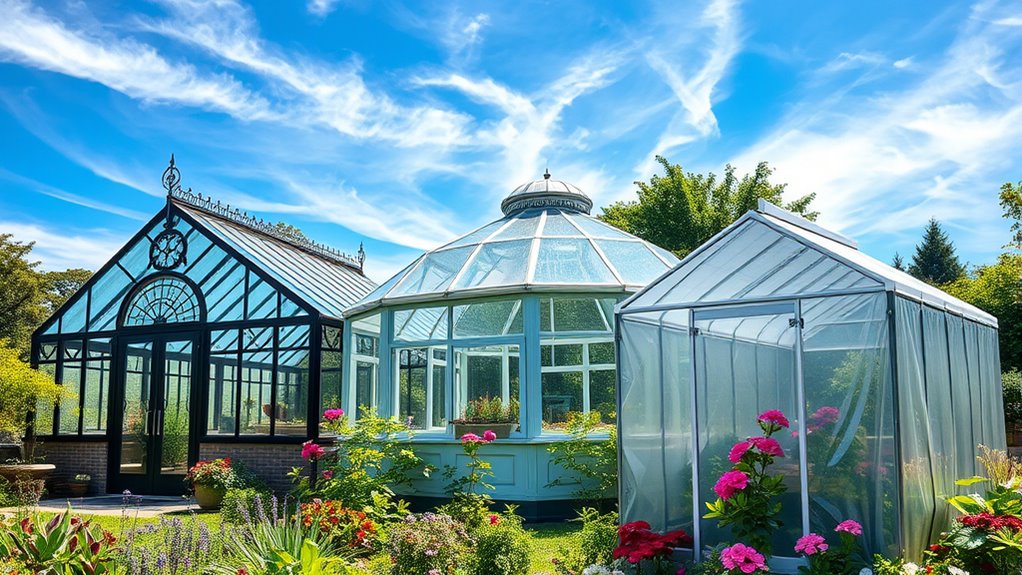
Selecting the right greenhouse can considerably impact your gardening success, whether you’re growing vegetables, flowers, or exotic plants. When choosing a greenhouse, it’s essential to consider how its design and features will support your specific needs. For instance, integrating solar heating can help maintain a consistent temperature, especially during colder months. Solar panels or passive solar designs absorb sunlight during the day and release heat at night, reducing your reliance on supplemental heating and lowering energy costs. This eco-friendly approach not only keeps your plants warm but also promotes sustainability. Additionally, a well-designed greenhouse can enhance pest control, minimizing the need for chemical treatments. Proper ventilation, screening, and strategic layout make it easier to keep pests out, creating a healthier environment for your plants. The choice of materials can significantly influence light transmission, insulation, and durability, impacting your greenhouse’s overall performance. Size is another crucial factor. You need to evaluate how much space your plants require and how much room you’ll need to work comfortably. A too-small greenhouse might restrict your plant choices, while an oversized structure could be more costly and difficult to heat or cool efficiently. Think about your current gardening goals and potential future expansion. If you’re starting small, a modest size might suffice, but if you envision growing a wide variety of plants or even starting a small nursery, larger models will serve you better. Remember, a well-ventilated space helps regulate temperature and humidity, which are vital for preventing mold and pests, so consider how your chosen size will accommodate proper airflow. Choosing the right materials not only affects light and heat retention but also impacts the overall longevity and maintenance needs of your structure. Ultimately, selecting the right greenhouse involves balancing your space, budget, and gardening ambitions. By prioritizing features like solar heating for efficient warmth and thoughtful pest control measures, you set a strong foundation for a thriving garden. Choose a size that offers room to grow without overwhelming your space or budget, and select materials that suit your climate and maintenance capabilities. With careful consideration, you’ll create a greenhouse that not only nurtures your plants but also simplifies your gardening experience, leading to healthier crops and more satisfaction in your outdoor oasis.
Frequently Asked Questions
How Do I Maintain Optimal Humidity Levels in My Greenhouse?
To maintain ideal humidity levels, you should regularly monitor moisture using a reliable hygrometer. Place a humidifier strategically—preferably near plants or air circulation points—to evenly distribute moisture. Adjust the humidifier based on your readings to prevent excessive or too-low humidity. Additionally, use ventilation and water trays to help regulate moisture, ensuring a healthy environment for your plants and avoiding issues like mold or dehydration.
What Are the Best Ventilation Options for Different Greenhouse Types?
Oh, just slap some vents on it, right? Well, for effective ventilation design, you need to think about natural airflow management with roof vents or side louvers for passive cooling. For larger greenhouses, exhaust fans and intake vents work wonders. Automated systems that adjust airflow based on temperature and humidity are even better. Remember, good airflow keeps your plants happy and prevents mold—so don’t skimp on proper ventilation options!
How Can I Prevent Pests and Diseases in My Greenhouse Environment?
To prevent pests and diseases in your greenhouse, you should implement integrated pest management (IPM) strategies. Use biological controls like ladybugs or predatory mites to naturally reduce pest populations. Keep your environment clean, monitor plants regularly, and remove infected foliage promptly. Proper ventilation and humidity control also help prevent disease spread. Combining these methods creates a healthy, pest-resistant environment, keeping your plants thriving and reducing chemical reliance.
What Are Cost-Effective Heating Solutions for Year-Round Gardening?
You’re hitting the nail on the head with cost-effective heating solutions. Rely on passive solar techniques by positioning your greenhouse to maximize sunlight, and add thermal mass like water barrels or concrete to absorb heat during the day and release it at night. These methods work hand-in-glove, reducing energy costs and keeping your plants cozy year-round without breaking the bank.
How Do I Select the Right Soil and Watering Systems for My Greenhouse?
To select the right soil and watering systems, start by choosing soil amendments that improve drainage and nutrient content, tailored to your plants’ needs. Set a consistent watering schedule, avoiding over- or under-watering. Consider installing drip irrigation or soaker hoses for efficiency, ensuring your plants receive steady moisture. Regularly monitor soil moisture levels, and adjust your watering routines accordingly to keep your greenhouse thriving year-round.
Conclusion
Now that you’ve explored the different types, sizes, and materials, you’re practically a greenhouse expert! Choosing the perfect one might seem intimidating, but remember—your decision could turn your garden into a lush paradise or a plant paradise that even the weather envies. With the right greenhouse, you’ll grow healthier, happier plants than ever before, transforming your space into a botanical wonderland so incredible, even the birds will stop and stare. The garden of your dreams is just a choice away!
